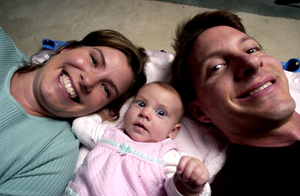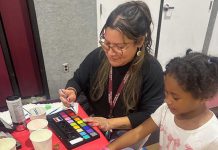After separate battles with cancer and three years of fertility
treatments, a Hollister couple welcomes first child
One glance around the Schaal home tells a fairly common
story
– a baby lives there.
There is the fuzzy receiving blanket tossed over the back of a
couch, an empty bottle near the kitchen sink. A glimpse into an
open doorway reveals a pastel-painted room and a crib with bright
bedding placed against the wall.
After separate battles with cancer and three years of fertility treatments, a Hollister couple welcomes first child
One glance around the Schaal home tells a fairly common story – a baby lives there.
There is the fuzzy receiving blanket tossed over the back of a couch, an empty bottle near the kitchen sink. A glimpse into an open doorway reveals a pastel-painted room and a crib with bright bedding placed against the wall.
Christine and Mike Schaal are first-time parents, and it shows – they are happy, anxious, and a bit tired, just like any other new mom and dad. But the Schaals’ road to parenthood was bumpier than most. Christine and Mike are cancer survivors, and treatment had reduced the chances of having a child of their own to a 50-50 proposition. Today, they call 3-month-old Olivia their “miracle baby.” It cost the couple more than $30,000 to get to this moment – a moment they say was worth every penny.
“It was a miracle we were both alive”
Christine always wanted to be a mom.
So when she was diagnosed in 1997 with acute lymphoblastic leukemia, a cancer of the white blood cells, one of her first concerns was the effect the disease would have on her ability to have children.
“I knew I wanted kids, even then,” Christine said. “When I first learned I had leukemia, I wanted them to harvest some of my eggs and freeze them. But I had such a rapidly spreading disease the doctors did not want to wait for my next menstrual cycle before starting treatment. To be honest, I was 18 years old. The doctors weren’t really thinking about my having a baby. They just thought about saving me.”
She began treatment, and two years later, Christine was in remission. She had begun the maintenance phase of her treatment, and the former high school athlete was anxious to start exercising again. She signed up with the Leukemia and Lymphoma Society to do a triathlon featuring swimming, biking and running.
“I wanted to do something positive,” Christine said. “I had swam, played softball and ran track in high school, and I missed the camaraderie, the competitiveness. The triathlon was my way of getting back into shape.”
One afternoon, as she ran laps around a local track, a young man began to run along side her. She didn’t know him, but as he passed Christine, he left a definite impression.
“I had seen Mike running laps, but the funny thing was, he had an identical twin brother and I didn’t know it,” she said with a smile. “I thought he was lapping me.”
Afterwards, the two talked, and Mike told Christine that he had been diagnosed in 1990 with Hodgkin’s Lymphoma, a cancer found in the lymph nodes, spleen, liver, and bone marrow.
“It was a rough six years of treatment [following his diagnosis],” Mike said. “After that first year, I began therapy, but every time I tried to get back in shape, I would get sick, get pneumonia. After years of this, a friend wanted me to do the triathlon. It was hard but I did it. The amazing thing is, since I did it, I’ve never gotten sick like that again.”
After the triathlon, Mike and Christine began dating, and for the next three years they worked out and competed as honorees with the society’s Team in Training program, which raises funds for leukemia, lymphoma and myeloma research and patient services.
“It helped us stay in shape, and that was important to us,” Mike said.
The couple married in 2002, knowing that having children of their own might be a problem.
“It was a miracle we were both alive,” Mike said. “All of the other patients that were treated at the same time as Christine have passed away. We went into the marriage knowing we had just a 50-50 chance of having a baby. But it gave us a common bond that no one else could understand. We had a connection.”
“The natural way wasn’t working for us”
In 2004, Christine and Mike moved to Hollister after Mike received his doctorate in physical therapy from a St. Louis university. He took a job with Fritter and Schultz, a local physical therapy clinic, and Christine began working with the Leukemia and Lymphoma Society, moving her way up to become a Team in Training manager for the Monterey Bay area. The couple bought a new home in Ridgemark. They both felt life was pretty good. Just one thing was missing – a baby.
“Once we moved here, we really started trying,” Christine said. “But the natural way wasn’t working for us. We decided we needed help.”
Christine contacted her local obstetrics and gynecology doctor, Aslam Barra, and inquired about fertility treatments. She began taking fertility drugs, and Mike took medicine as well to increase his sperm count and hormone levels.
“Most cancer patients don’t get their periods back after treatment, but I did and that was a good sign,” Christine said. “The doctors liked our chances. We kept with the drugs, tried the calendar method. It was just like what you hear ‘honey, hurry, I’m ovulating!’ We really tried everything.”
A year later, the couple had still not conceived. They went to a fertility doctor in Monterey. Christine underwent an inuterine insemination (IUI), commonly used when a woman doesn’t have a partner, or her partner is also female or if there is borderline male factor infertility.
“They left my eggs inside of me and then injected Mike’s sperm into me,” Christine explained matter-of-factly. “We did that twice over a six-month period and finally decided that wasn’t working. So we changed doctors, switching to a fertility doctor in Salinas. We tried in vitro fertilization treatments with him, but it felt like he wasn’t treating our personal situation, or paying attention to our history. He looked at us like a couple with regular fertility problems, and we weren’t. It was very frustrating.”
“Olivia is our $30K baby”
Another obstacle Christine and Mike faced in their struggle to conceive a child was the cost. One in vitro fertilization treatment costs an average of $10,000; the fertility drugs Christine was taking cost more than $2,000 a month. Although both had good jobs, the cost, as well as the stress, began taking its toll.
“We were becoming broke, and getting frustrated,” Christine said. “Medical insurance doesn’t cover these types of costs. We started looking into adoption.”
But adoption wasn’t the answer for Christine, who said the desire to have her own child was overwhelming.
“I felt gypped with adoption. I didn’t feel like a woman,” she said. “I wanted to be pregnant. I wanted the whole experience – the cravings, the morning sickness, the big stomach. I wanted it all.”
As her frustration grew, Christine said it became hard for her to even be around pregnant women.
“I was just angry at the whole process,” she said. “I would see mothers on the street and get upset that they had children and I couldn’t. It was so upsetting for me. I couldn’t even look at mothers and babies.”
Rather than give up – “we are both stubborn and hard-headed,” Christine said – she called her hematologist (cancer survivors have regular yearly check-ups as maintenance), who recommended the Schaals call the Stanford Fertility Reproductive Medicine Center, a state-of-the-art clinic that specializes in tailoring treatments to meet patient needs. Christine was referred to Lynn Westphal, a fertility doctor at the clinic, who understood the Schaals’ situation. She requested a series of genetic testing on both Mike and Christine. They discovered two things – Mike had a low sperm count, and while Christine was producing a large quantity of eggs, not all of them were viable.
“No one would tell us why the treatments weren’t working,” Mike said. “The doctors said we should just keep trying, but we couldn’t afford that. But I’m glad we didn’t give up until we got an answer.”
Westphal recommended the pair use intracyctoplasmic sperm injection (ICSI), a procedure where sperm is injected directly into mature eggs that have been removed from a woman’s ovaries; fertilized eggs are returned to the uterus within two to five days. Westphal implanted three fertilized eggs into Christine’s womb, one of which took.
“It worked the first time. We were lucky,” Christine said. “We had borrowed money from family to help cover costs. We had said we would give it two tries, but I couldn’t just let it go. They [doctors] tell you to put a number on it, how many times you will try, but it is so hard when you want something so badly. I had to keep trying. Olivia is our $30,000 baby.”
Although the Schaals received financial help from family, there are several companies that provide loans for infertile couples seeking treatment, and Christine said many clinics offer monthly payment plans.
“We paid in installments,” she said. “We had to borrow. But people are generous. There is more help out there than people realize. In the long run, it’s worth it. You can’t put a price on it.”
“People spend $30,000 on a car,” Mike said. “I’d rather have Olivia.”
“Don’t give up”
Christine’s pregnancy was considered high risk, and the mother-to-be said she followed every instruction from her doctor to the letter.
“I couldn’t exercise at all; I couldn’t even lift anything over 10 pounds – that included my cat,” she laughed. “I really stuck to every thing they told us. I was nervous, but as the months went by, things got better. I chose to err on the side of caution. I think most women would in that situation.”
In many fertility cases, more than one embryo will take hold, resulting in multiple births. Christine and Mike said they talked about the possibility of conceiving two or more children with one pregnancy, but ultimately decided not to worry about it.
“At first I said ‘put in six eggs, and I’ll have all my kids at once,'” Christine laughed. “Of course, that was before I actually gave birth. But we weren’t worried about [multiples]. We just wanted healthy babies.”
Olivia was born via a Cesarean delivery on July 12, three weeks early. Today, she is a healthy three-month-old girl and her parents couldn’t be happier.
“Life is pretty perfect right now,” Mike said, as he smiled at his daughter, who was asleep in his arms.
There are two challenges still facing the Schaals, the first being the possible recurrence of their respective cancers.
“It’s always in the back of my mind,” Mike said. “After five years, you are referred to as ‘cured.’ But we still get checked every year, and in my case, I’m more likely to get cancer from the treatment itself. But we are called survivors, so the fear [of recurrence] is lessening as time goes on.”
The second challenge Christine and Mike face is fulfilling Christine’s desire for more children.
“At first, I told Mike I didn’t want to try for another one,” Christine said. “Not only was this a very emotional experience, but there are so many things you can’t do when you are undergoing fertility treatments – you can’t exercise, you can’t have intercourse. You can’t live your life.”
“For two years, our life was put on hold,” Mike added. “It put a lot of stress on our relationship. We would blame ourselves, and then we would blame each other. It was hard. It really affects every part of your life.”
Christine is hopeful she will be able to conceive a second child naturally, now that the pressure of conceiving once has been lifted. But if the couple has to use in vitro again, both say they would consider it.
“I am not as anxious this time, so we’ll see what happens,” Christine said. “I’m not going to kill myself trying – we have a beautiful daughter – but right now, my body responds great to the medication, so I think we should try again soon.”
“I think we’ll try letting nature take its course first,” Mike said. “See what happens. The cost [of an in vitro procedure] is … well, we just can’t do it over and over again.”
Although they have been through some very traumatic experiences, both separately and as a couple, Christine and Mike continue to look at life in a positive light.
“When I got cancer, I remember one of my doctors telling me, ‘it’s not the cards you are dealt, but how you play the hand.’ But I was 18 years old. I was angry,” Christine said. “On top of that, I went through three years of fertility treatments. You feel like ‘why me?’ But if I could give just one message, it would be ‘don’t give up.’ Olivia is our light at the end of the tunnel.”
Medicine has evolved ways around infertility
Options for conception abound for families seeking a baby
Christine and Mike Schaal’s infertility woes may sound unique, but conceiving a child is not always as easy as one might think.
Simply put, infertility is the inability of a couple to become pregnant, regardless of the reasons, after one year of sexual intercourse while using no birth control methods. Infertility affects about 6.1 million people in the United States – or nearly 10 percent of all men and women of reproductive age.
Technology has provided ways for infertile couples to have a biological child. In 1981, in vitro fertilization (IVF) was used in the United States successfully for the first time. Since then, more than 250,000 babies have been born nationwide as a result of IVF.
As with the Schaals, most fertility doctors will recommend other, more natural types of treatment – such as monitoring ovulation cycles or changes in diet – as well as hormone therapy before considering IVF. Less than 5 percent of infertile couples actually end up using a form of IVF, and then it is usually used with women who have blocked or severely damaged fallopian tubes, or women who have had their tubes removed. It is also used to overcome infertility caused by endometriosis in women (the growth of cells much like the ones that form on the inside of the uterus but in a location outside of the uterus) or low sperm count in men. Couples who have exhausted all other methods and still have not conceived also try IVF.
With IVF, a man’s sperm and the woman’s egg are combined in a Petri dish where fertilization takes place. After fertilization, the created embryo is implanted in the woman’s uterus to develop naturally. Typically, anywhere from two to four embryos are implanted at one time.
Recent advancements in IVF treatments include the creation of new procedures, such as intracyctoplasmic sperm injection (ICSI), the method used by the Schaals. With ICSI, mature eggs are removed from a woman’s ovaries. Next, sperm is injected one at a time directly into each of the removed eggs (in traditional IVF, sperm are placed close to the egg and must enter the egg in order for conception to take place). Within two to five days, each of the fertilized eggs should have grown into an embryo; two to four will be placed into the woman’s uterus.
ICSI was first introduced in 1992, and was hailed as a breakthrough in treating male infertility problems. Approximately 24,000 ICSI babies are now born each year in the United States. When ICSI is not a viable option, there are several alternative procedures available.
Although the Schaals went through three procedures before conceiving their daughter Olivia, the pregnancy rate, by age, through IVF is similar to the rate of a normal conception. On average, 37 percent of women younger than 35 years, and 28 percent of women ages 36-39, conceive using IVF.
The IVF success rate declines as a woman grows older – only 13 percent of women 40 or older conceive, and pregnancy in women older than 44 is rare. And while it is common for many women to fear losing their baby during the first trimester, the miscarriage rate with IVF pregnancies is about the same as a normally conceived pregnancy.










